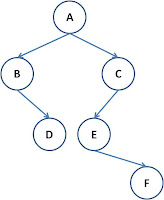1. Given a time-sheet of employees entrance and exit from an office over a period of month, provide an algorithm to find the number of employees at any given point of time.
Time-Sheet Format
Date In Out
mm:dd:yyyy hr:min:sec hr:min:sec
01:01:2012 06:00:00 16:00:00
................. ............. .............
14:01:2012 06:30:00 17:05:00
................. .............. ..............
Given query time 03:01:2012 00:00:00
Find all the employees in the office at the given time.
2. Develop a method to sort an array of strings such that all the anagrams are next to each other.
Hint: sort each string alphabetically. Now, all the anagrams will have the same string representation. Then, either perform a lexicographical sort or use the string as key to hash in a hash-map
3. Given an array of strings , find the first unique occurring string.
For example let S= {"ab","ac","ab","bd","ac","edf"} be an array of strings. The first unique string is "bd".
4. Given an integer N, find all the prime numbers less than or equal to N.
Hint: Use Sieve of Eratosthenes algorithm
5. Find the Nth prime number.
Answer: No such general formula exists. There are few constrained formulations.
Details: prime number types , formula of primes, formula of primes 2 , formula of primes 3, formula of primes 4
6. Given a file of billion of numbers, write a program to remove the duplicates.
7. Given a matrix of 1's and 0's, write a program to find
a) Largest square sub-matrix of only 1's
b) Largest rectangular sub-matrix of only 1's
8. Find the median of two sorted arrays.
9. Find the Kth largest element in an unsorted array or find top-k elements in an array.
( Hint: Selection Algorithm (median-of-median linear time algorithm) )
Time-Sheet Format
Date In Out
mm:dd:yyyy hr:min:sec hr:min:sec
01:01:2012 06:00:00 16:00:00
................. ............. .............
14:01:2012 06:30:00 17:05:00
................. .............. ..............
Given query time 03:01:2012 00:00:00
Find all the employees in the office at the given time.
2. Develop a method to sort an array of strings such that all the anagrams are next to each other.
Hint: sort each string alphabetically. Now, all the anagrams will have the same string representation. Then, either perform a lexicographical sort or use the string as key to hash in a hash-map
3. Given an array of strings , find the first unique occurring string.
For example let S= {"ab","ac","ab","bd","ac","edf"} be an array of strings. The first unique string is "bd".
4. Given an integer N, find all the prime numbers less than or equal to N.
Hint: Use Sieve of Eratosthenes algorithm
Answer: No such general formula exists. There are few constrained formulations.
Details: prime number types , formula of primes, formula of primes 2 , formula of primes 3, formula of primes 4
6. Given a file of billion of numbers, write a program to remove the duplicates.
7. Given a matrix of 1's and 0's, write a program to find
a) Largest square sub-matrix of only 1's
b) Largest rectangular sub-matrix of only 1's
8. Find the median of two sorted arrays.
9. Find the Kth largest element in an unsorted array or find top-k elements in an array.
( Hint: Selection Algorithm (median-of-median linear time algorithm) )
